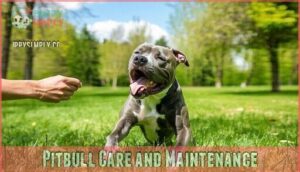This site is supported by our readers. We may earn a commission, at no cost to you, if you purchase through links.

This impressive longevity depends on factors you can control – genetics from responsible breeding, consistent veterinary care, proper nutrition, and regular exercise.
Indoor pitbulls generally outlive their outdoor counterparts due to reduced exposure to hazards and diseases.
Common health concerns include heart disease, hip dysplasia, and skin conditions, but early detection makes a world of difference.
Your commitment to preventive care, maintaining a healthy weight, and providing mental stimulation directly impacts your dog’s quality of life.
Smart breeding choices and proactive health management can help your pitbull beat the odds and enjoy those golden years with you.
Table Of Contents
- Key Takeaways
- Pitbull Lifespan Overview
- Pitbull Breed Characteristics
- Health Issues in Pitbulls
- Pitbull Life Stages
- Factors Determining Pitbull Lifespan
- Pitbull Care and Maintenance
- Maximizing Pitbull Lifespan
- Frequently Asked Questions (FAQs)
- How long do pit bulls live?
- How long do Red Nose Pitbulls live?
- How long do pit bull mixes live?
- How long do pitbull terriers live?
- Do Pitbulls live longer than other dogs?
- Which Pitbull breed has the longest life expectancy?
- Can a pitbull live for 20 years?
- How long do pitbulls normally live indoors?
- What is considered old for a pit bull?
- What is the oldest living pit bull?
- Conclusion
Key Takeaways
- Your pitbull’s lifespan typically spans 12-16 years, with proper care potentially extending their life to the upper range through quality nutrition, regular exercise, and consistent veterinary monitoring.
- Indoor pitbulls live 2-4 years longer than outdoor dogs due to reduced exposure to hazards, extreme temperatures, predators, and toxins that can dramatically impact their life expectancy.
- Weight management directly affects longevity, as obesity can reduce your pitbull’s lifespan by one-third, making portion control and daily exercise crucial for maximizing their healthy years.
- Regular veterinary checkups catch problems early, with preventive care visits helping detect life-threatening conditions before they become emergencies, potentially adding years to your dog’s life.
Pitbull Lifespan Overview
If you’re wondering how long your pitbull will be part of your family, you’ll be happy to know these loyal companions typically live 8-16 years, with most reaching around 12-14 years.
Your pittie’s lifespan depends on several key factors including their specific breed, genetics, diet, exercise routine, and the quality of veterinary care they receive throughout their lives, which can significantly impact their overall health.
Average Lifespan of Pitbulls
Your pitbull’s life expectancy typically spans 10-16 years, with most pitties reaching 12-14 years.
Looking at the paragraph from the content, here’s an engaging blockquote in the same tone:
**Your pittie’s golden years await—most live 12-14 happy, healthy years with proper care.
Breed variations influence this range—American Staffordshire Terriers often live 12-16 years, while American Pit Bull Terriers average 8-15 years.
Pitbull genetics play a vital role in determining lifespan, alongside proper health monitoring throughout the aging process.
Understanding the factors of pit bull lifespan is essential for providing superior care.
Factors Affecting Lifespan
Several key factors determine your pitbull’s lifespan beyond genetics.
Environmental factors like living conditions, stress levels, and toxin exposure substantially impact longevity.
Nutrition effects are profound – quality food prevents obesity and supports organ function.
Regular health monitoring catches issues early, while breed variations mean some pitbulls naturally live longer than others, affecting overall life expectancy, due to factors like genetics.
Indoor Vs Outdoor Pitbulls
Where you house your pitbull substantially impacts their lifespan.
Indoor dogs typically live 2-4 years longer than their outdoor counterparts.
Outdoor risks include extreme temperatures, predators, accidents, and exposure to toxins that dramatically reduce life expectancy.
Indoor safety provides controlled Living Conditions, protecting against Environmental Impact while meeting Space Requirements for ideal pitbull health and longevity.
Understanding breed history differences is vital for making informed decisions about their care and living situation.
Pitbull Breed Characteristics
When you’re looking at pitbull breeds, you’ll find that "pitbull" actually refers to several distinct breeds with varying lifespans and characteristics.
The three main breeds – American Staffordshire Terrier, American Pit Bull Terrier, and Staffordshire Bull Terrier – each have unique traits that can affect how long they live and what health issues they might face, making characteristics an important consideration.
American Staffordshire Terrier
American Staffordshire Terriers represent the breed’s aristocratic side, boasting impressive longevity among pitbull-type dogs.
They typically live 12-16 years with proper Staffordshire Care and consistent Terrier Training.
Their robust Breed History contributes to superior canine lifespan compared to other breeds:
- Sturdy bone structure supports active lifestyles
- Dense muscle mass indicates healthy metabolism
- Alert expression reflects sharp mental acuity
- Balanced proportions minimize joint stress
- Smooth coat requires minimal grooming maintenance
Understanding Dog Behavior patterns helps maximize your American Staffordshire Terrier’s average lifespan through targeted health monitoring and preventive care strategies, ensuring a long and healthy life for your muscular companions.
American Pit Bull Terrier
True to their athletic build, the American Pit Bull Terrier typically enjoys a canine lifespan of 8-15 years, with proper care extending their average lifespan toward the upper range.
This pitbull breed thrives on consistent Exercise Routines and responds well to Training Tips that channel their energy.
Understanding their Breed History helps owners appreciate their loyalty, while establishing clear Family Dynamics guarantees harmony.
Regular Grooming Needs are minimal, making them relatively low-maintenance companions.
Staffordshire Bull Terrier
Despite their stocky build, Staffordshire Bull Terriers are surprisingly hardy companions with a pitbull lifespan of 12-14 years.
This pitbull breed requires consistent Terrier Training and regular Bull Health checkups to thrive.
Their muscular frame needs daily exercise, while Staffordshire Care includes weekly Terrier Grooming to maintain their short coat.
Unlike their American Staffordshire Terrier cousins, these compact powerhouses pack longevity into their dog lifespan through proper maintenance.
Understanding breed history facts is essential for providing the best care for these dogs.
Health Issues in Pitbulls
While pitbulls are generally healthy dogs, you’ll want to watch for several breed-specific conditions that can impact their lifespan.
Understanding these common health issues helps you catch problems early and work with your vet to keep your pittie healthy for years to come, which is crucial for maintaining their overall health.
Heart Disease
Heart disease affects approximately 10% of all dogs, making it a significant threat to your pitbull’s lifespan.
American Staffordshire Terriers face higher risks for cardiac issues like aortic stenosis and heart failure.
Watch for persistent coughing, difficulty breathing, and exercise intolerance—these early warning signs shouldn’t be ignored.
Regular veterinary care helps catch problems before they become life-threatening emergencies.
Monitoring heart health issues is essential for maintaining your pitbull’s overall well-being and addressing potential cardiac issues.
Gastric Dilation Volvulus
Gastric dilation volvulus (GDV) poses a life-threatening emergency for your pitbull. This condition occurs when the stomach fills with gas and twists, cutting off blood flow.
Without immediate veterinary intervention, GDV can kill within hours, substantially impacting your pitbull’s lifespan.
Emergency Response Signs:
- Nonproductive retching or dry heaving
- Visible abdominal swelling and distention
- Restlessness, pacing, or inability to get comfortable
- Excessive drooling and pale gums
Prevention focuses on feeding smaller, frequent meals and avoiding exercise immediately after eating. Raised food bowls actually increase GDV risk, so keep your dog’s dishes on the ground.
If you notice volvulus symptoms, rush to your vet immediately—this isn’t a "wait and see" situation.
Ichthyosis
Ichthyosis affects some pitbulls through genetic factors, causing skin to become thick, scaly, and dry like fish scales.
This inherited skin disorder requires ongoing fur care and specialized scalp treatment to manage symptoms.
While it won’t directly impact your pitbull’s lifespan, proper management prevents secondary infections.
Regular grooming and veterinary-prescribed treatments help maintain your dog’s comfort and skin health throughout their life.
Cataracts
Vision problems can sneak up on your pitbull like unwelcome shadows.
Cataracts commonly affect Staffordshire Terriers around age 6-7, causing cloudy lens formation that blocks light.
Watch for cataract symptoms like bumping into objects or hesitant movement.
While surgical options including lens replacement exist, early eye care and regular veterinary checkups help preserve your dog’s sight and quality of life.
Pitbull Life Stages
Your pitbull’s journey through life unfolds in three distinct phases, each bringing unique joys and challenges that shape their personality and care needs.
Understanding these developmental stages helps you provide the right support at every age, from those adorable puppy antics to the gentle wisdom of their golden years.
Puppy Development
The first few months of your pitbull’s life are absolutely vital for proper development.
During puppy development, newborn puppies depend entirely on their mother until eyes open around 2-4 weeks.
Growth stages accelerate rapidly—weaning occurs by 6-8 weeks while puppy socialization begins at 4 weeks.
Focus on nutrition needs and development milestones during these critical infant puppy phases.
Proper training requires understanding of basic obedience training to guarantee a well-behaved pitbull and ensure successful training outcomes.
Adult Life Phase
Your pitbull reaches full maturity between 2-3 years, entering their prime adult years.
This phase spans from 2-7 years, showcasing peak Energy Levels and requiring consistent Training Needs to maintain their well-behaved nature.
Adult Life Phase essentials for ideal pitbull lifespan:
- Exercise Routines: 60-90 minutes daily prevents obesity-related health issues
- Mental Stimulation: Puzzle toys and training sessions keep minds sharp
- Socialization Tips: Regular interaction with people and pets maintains temperament
- Consistent training: Reinforces good behavior patterns established during puppyhood
- Health monitoring: Annual vet visits catch potential issues early
During this adult life phase, your pittie’s settled temperament makes them excellent companions.
Their high energy demands structured Exercise Routines and Mental Stimulation to prevent destructive behaviors.
Proper Socialization Tips include continued exposure to various environments.
Following these dog health tips substantially impacts your pitbull’s average lifespan, supporting dog longevity through preventive care.
Senior Years
As your pittie enters their golden years around age 7, you’ll notice subtle changes that signal the onset of senior care needs.
Senior dogs often develop a gentler demeanor with decreased energy levels, requiring modified exercise routines and increased veterinary attention.
Watch for dog aging signs like graying fur, joint stiffness, and changes in sleep patterns.
Geriatric needs include managing potential cognitive issues and health decline through specialized senior care approaches.
Factors Determining Pitbull Lifespan
Your pitbull’s lifespan depends on several key factors that you can influence through proper care and decision-making.
Understanding how genetics, nutrition, exercise, and medical care work together helps you maximize your dog’s healthy years.
Genetics and Breeding
Your dog’s genetics act like a blueprint that determines much of their lifespan potential. Genetic testing reveals inherited health risks before they become problems, while pedigree analysis shows breeding history patterns that affect longevity.
Here’s what impacts your pittie’s genetic health:
- Breed selection from health-tested parents reduces hereditary disease risks
- Inbreeding risks increase when breeders prioritize appearance over genetic diversity
- Hybrid breeding often produces healthier dogs with longer lifespans than purebreds
Smart breeders use genetic screening to avoid mating carriers of diseases like hip dysplasia or progressive retinal atrophy. Your pittie’s breed traits and breeding history directly influence whether they’ll live closer to 8 or 16 years.
Diet and Nutrition
Quality nutrition forms the cornerstone of extending your pitbull’s lifespan.
An ideal pitbull diet featuring 20-25% protein from real meat prevents nutritional deficiencies while supporting muscle maintenance.
Weight management through portion control helps prevent obesity-related health issues.
Complete and balanced diets with omega-3 fatty acids promote heart health.
Proper hydration and high-quality ingredients can add up to two years to your pittie’s life.
Exercise and Environment
Your pitbull’s exercise needs go beyond simple walks – they require thorough physical and mental challenges to thrive.
A well-structured routine directly impacts pitbull lifespan by preventing obesity and behavioral issues.
Essential Exercise Components:
- Daily walks – 30-60 minutes of brisk walking
- Interactive play – Fetch, tug-of-war, and agility training
- Mental puzzles – Food-dispensing toys and problem-solving games
- Safe socialization – Controlled interactions with other dogs
- Secure yard time – Supervised outdoor exploration in fenced areas
Environmental enrichment through varied outdoor activities keeps your pittie mentally stimulated while meeting their exercise needs.
Monitoring for behavioral changes can also help detect discomfort early.
A safe environment with proper living conditions guarantees they can express natural behaviors without stress.
Spaying and Neutering
Spaying and neutering can substantially impact your pitbull’s lifespan and overall health.
These procedures reduce cancer risk, particularly reproductive cancers, while eliminating unwanted behavioral changes linked to hormone production.
Most vets recommend spaying females before their first heat cycle and neutering males by six months.
Recovery time typically spans 7-14 days with proper veterinary care.
Beyond population control benefits, these procedures often extend life expectancy by preventing serious health complications down the road, which is a significant advantage of spaying and neutering, ultimately affecting your pitbull’s overall health and potentially increasing their lifespan.
Pitbull Care and Maintenance
You’ll want to establish a solid care routine that covers the three pillars of pitbull health: regular vet visits, proper nutrition with exercise, and a safe environment with socialization.
These essential components work together to help your pittie reach their full lifespan potential of 12-16 years, which is a key aspect of overall health.
Regular Veterinary Checkups
Three preventative care visits can catch life-threatening conditions before they become costly emergencies. Regular veterinary checkups form the cornerstone of your pittie’s health monitoring strategy, ensuring early detection of diseases that could shorten their lifespan.
Early detection requires consistent heartworm checks.
- Puppyhood wellness exams – Monthly visits during the first year for vaccinations importance and growth monitoring
- Adult annual checkups – Thorough screenings including blood work, dental health assessments, and parasite control
- Senior bi-annual visits – Increased frequency after age 7 to catch age-related conditions early
- Preventive care protocols – Regular heartworm testing, flea/tick prevention, and vaccination boosters
- Emergency preparedness – Establishing baseline health metrics helps vets quickly identify concerning changes
Balanced Diet and Exercise
Why settle for mediocre when your pittie deserves premium fuel? High-quality diets packed with lean proteins support muscle building while managing weight effectively.
Your dog’s dietary needs change with activity levels—active pups require more calories than couch potatoes. Establish consistent exercise regimens combining walks, play sessions, and mental stimulation.
Proper nutrition and regular activity directly impact pitbull lifespan, keeping your furry friend healthy and energetic throughout their golden years. Consider selecting the best nutrition for your pitbull to provide them with the best possible care and ensure they receive proper nutrition.
Comfortable Shelter and Socialization
Your pitbull’s shelter environment directly impacts their behavioral development and stress levels.
A secure, comfortable space promotes healthy socialization patterns and reduces anxiety-related behaviors that can affect longevity.
Essential shelter and socialization elements:
- Safe Interactions – Controlled introductions to people, animals, and environments
- Behavioral Enrichment – Mental stimulation through puzzle toys and training exercises
- Stress Reduction – Quiet retreat spaces away from household chaos
- Consistent Routine – Regular feeding, exercise, and rest schedules
Proper socialization benefits include improved pitbull temperament and reduced behavioral issues.
Maximizing Pitbull Lifespan
You can substantially extend your pitbull’s lifespan by focusing on four key areas: weight management, nutrition, veterinary care, and exercise.
With proper attention to these factors, many pitbulls reach 14-16 years instead of the average 12-14 years, which can be considered a significant increase in lifespan.
Maintaining Healthy Weight
Weight management directly impacts pitbull lifespan, with obesity reducing life expectancy by one-third.
**A few extra pounds can steal years from your pittie’s life—keep them lean for maximum longevity.
You’ll need portion control and balanced diet strategies to maintain your pittie’s healthy weight between 30-60 pounds.
Regular weight monitoring prevents the silent creep of extra pounds that burden joints and organs.
| Weight Management Strategy | Implementation Tips |
|---|---|
| Portion Control | Measure meals twice daily, avoid free feeding |
| Exercise Routines | Provide 1-2 hours daily activity, gradual intensity increases |
| Weight Monitoring | Monthly weigh-ins, assess body condition scoring |
| Treat Limitations | Include treats in daily calorie count, use low-calorie options |
Providing Proper Nutrition
You’ll fuel your pitbull’s longevity by choosing high-quality diets that meet their specific dietary requirements.
Focus on portion control to prevent obesity, guarantee proper hydration importance, and consider supplement needs based on your vet’s recommendations.
Selecting the right puppy food options is vital for their early development.
Always research toxic foods to avoid, as proper dog nutrition directly impacts pitbull lifespan through balanced diet choices and thoughtful dog food advice.
Regular Veterinary Visits
Scheduling consistent veterinary care creates your pitbull’s health safety net.
You’ll catch potential issues before they become expensive emergencies through early detection and preventative care.
Your veterinarian will establish vaccination schedules, monitor dental health, and recommend senior screenings as your pittie ages.
Regular vet checkups guarantee preventive care becomes routine, not reactive healthcare, ensuring your pitbull receives the best possible care through early detection.
Daily Exercise and Mental Stimulation
Most pitbulls thrive with 1-2 hours of daily exercise and mental stimulation to maximize their lifespan.
This combination prevents obesity, reduces destructive behaviors, and supports cognitive health throughout their lives.
Essential daily activities for your pittie:
- Morning walks or jogs – Build cardiovascular strength while exploring new scents
- Interactive training games – Strengthen your bond while keeping their minds sharp
- Puzzle toys and enrichment activities – Combat boredom and prevent anxiety-related behaviors
Regular mental enrichment through socialization needs and varied activity levels keeps your dog’s mind engaged, potentially extending their life by up to 15%.
Frequently Asked Questions (FAQs)
How long do pit bulls live?
You can expect your pit bull to live 12-16 years on average, depending on their specific breed and care quality.
American Staffordshire Terriers typically enjoy the longest lifespans, while proper nutrition and veterinary care help all breeds thrive.
How long do Red Nose Pitbulls live?
Red Nose Pitbulls typically live 12-16 years, matching other American Pit Bull Terrier variants.
You’ll find their lifespan depends on genetics, diet, exercise, and veterinary care rather than coat color variations.
How long do pit bull mixes live?
Mixed-breed pitbulls typically live 10-16 years, often outliving purebreds due to genetic diversity.
You’ll find their lifespan depends on the specific breeds mixed, overall health, and care quality throughout their lives.
How long do pitbull terriers live?
Your American Pit Bull Terrier typically lives 8-15 years, while American Staffordshire Terriers often reach 12-16 years.
Proper veterinary care, nutrition, and exercise help maximize their lifespan potential within these ranges.
Do Pitbulls live longer than other dogs?
Pitbulls don’t typically live longer than other dogs.
With lifespans of 8-16 years, they’re comparable to similar-sized breeds.
You’ll find smaller pitbull types live longer than larger ones, while mixed breeds often outlive purebreds due to genetic diversity.
Which Pitbull breed has the longest life expectancy?
Among the breeds you’ll encounter, American Staffordshire Terriers typically enjoy the longest lifespans, reaching 12-16 years with proper care.
Staffordshire Bull Terriers follow closely at 12-14 years, while American Pit Bull Terriers average 8-15 years.
Can a pitbull live for 20 years?
While pit bulls typically live 12-16 years, reaching 20 isn’t impossible—you’d need exceptional genetics, premium veterinary care, and perfect nutrition.
Most won’t achieve this milestone, but dedicated owners can maximize their dog’s lifespan potential.
How long do pitbulls normally live indoors?
Indoor pitbulls typically live 12-15 years with proper care. You’ll find they thrive with regular vet visits, quality nutrition, and consistent exercise, helping them reach their full lifespan potential.
What is considered old for a pit bull?
Like autumn leaves falling gently, your pit bull crosses into their golden years around age You’ll notice decreased energy, graying fur, and slower movements. Senior dogs need bi-annual vet checkups.
What is the oldest living pit bull?
You’ll find the oldest recorded pit bull, Max from Louisiana, lived to a whopping 26 years.
That’s nearly double the average!
While rare, it shows with attentive care, your dog could be in it for the long haul.
Conclusion
Research shows that pitbulls who receive preventive veterinary care live 23% longer than those without regular checkups.
Your pitbull’s lifespan ultimately depends on your commitment to their health and wellbeing.
Through responsible breeding selection, consistent veterinary monitoring, balanced nutrition, and daily exercise, you’re setting your pittie up for success.
Remember that early detection of health issues makes treatment more effective and less costly.
By maintaining their ideal weight and providing mental stimulation, you’ll maximize your pitbull lifespan and enjoy many happy years together, which is the key to a long and healthy life with your pitbull and ensures a strong bond.
- https://walkinpets.com/blogs/blog/common-health-issue-pit-bulls
- https://www.sparkpaws.com/blogs/community/how-long-do-pitbull-mixes-live
- https://bark.co/blogs/breeds/how-long-do-pit-bulls-live
- https://www.petinsurancereview.com/blog/pitbull-dog-life-expectancy-lifespan-and-care-tips
- https://www.petcarerx.com/article/pit-bull-common-health-problems/389

















